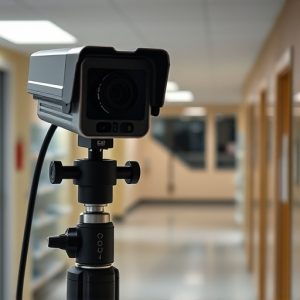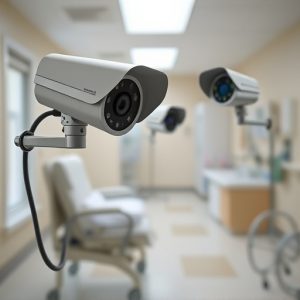Balancing Security and Privacy: Camera Usage in Nursing Homes
Cameras for nursing homes have sparked a debate on balancing resident safety with their right to pr…….
Cameras for nursing homes have sparked a debate on balancing resident safety with their right to privacy. It's essential that any surveillance system in these facilities protects the dignity and privacy of the elderly while ensuring their safety from abuse, neglect, and accidents. The use of CCTV cameras with wide-angle lenses for common areas, PTZ cameras for more intimate spaces, motion-activated cameras at entry points, and infrared cameras for round-the-clock monitoring are all strategies to enhance security without overstepping privacy boundaries. Surveillance must comply with privacy laws and ethical standards, and residents or their representatives must provide informed consent before installation. Data protection policies, access controls, and conditions for sharing footage with authorities are crucial to maintain trust and adhere to regulations like HIPAA. The integration of modern surveillance technology in nursing homes includes high-definition cameras with night vision, intelligent software for activity analysis, motion detection sensors, audio systems for sound monitoring, and AI for predictive analytics. These technologies support staff in identifying at-risk residents, detecting health issues, and ensuring quick response to incidents, all while providing a sense of security to families that their loved ones are being cared for in a safe and respectful environment.
When considering the well-being of nursing home residents, the integration of cameras for nursing homes becomes a topic of significant discussion. This article delves into the nuanced balance between enhancing safety and maintaining privacy within these facilities. We explore the necessity of camera systems in safeguarding resident welfare, the types of cameras most appropriate for such environments, and the best practices to navigate the complex legal frameworks surrounding surveillance. Additionally, we examine advanced features and technologies that can elevate security measures without compromising the dignity of eldercare. Join us as we navigate this delicate subject with a focus on both safety and respect.
Assessing the Need for Cameras in Nursing Homes: Ensuring Resident Safety and Privacy
In recent years, the debate surrounding the use of surveillance cameras in nursing homes has gained significant attention. Advocates argue that installing cameras is a proactive measure to enhance resident safety within these facilities. Cameras for nursing homes can provide round-the-clock monitoring, deterring potential abuse or neglect, and ensuring that staff are providing appropriate care. This technology can be particularly beneficial in high-risk areas where residents may be more vulnerable to accidents or mistreatment. However, the implementation of such systems must be balanced with the privacy concerns of elderly residents. It is crucial to establish clear policies that outline when and how footage is accessed and used, ensuring that the dignity and autonomy of residents are respected at all times. The right to privacy cannot be compromised in the pursuit of safety, and thus, any surveillance strategy should be complemented by stringent data protection measures and oversight by a trusted third party to safeguard residents’ rights. Facilities must navigate this delicate balance with care, ensuring that cameras for nursing homes serve as a tool for enhancing safety without infringing on privacy.
Types of Cameras Suitable for Nursing Homes: A Balance Between Security and Respect for Elders
When selecting surveillance systems for nursing homes, it is imperative to strike a delicate balance between security and respecting the privacy and dignity of the residents. Cameras for nursing homes must be discreet yet effective in monitoring areas where residents live and common spaces. High-definition CCTV cameras with wide-angle lenses are suitable for hallways and activity areas, ensuring that staff can monitor resident safety without intrusive visibility. In communal dining or recreational rooms, pan-tilt-zoom (PTZ) cameras allow for targeted monitoring when necessary, providing staff with the ability to focus on specific areas without compromising the overall atmosphere of comfort and home-like environment.
Furthermore, the use of motion-activated cameras can help minimize the feeling of constant surveillance while still offering protection against unauthorized access or potential incidents. These cameras can be positioned strategically at key entry points, storage rooms, and other areas where security is paramount but constant monitoring is not required. Infrared cameras are also an excellent choice for both indoor and outdoor surveillance as they can operate effectively in low-light conditions, ensuring safety around the clock without disrupting the nighttime routines of nursing home residents. It’s important to ensure that all camera installations adhere to privacy laws and ethical standards, fostering a secure environment that respects the rights and well-being of elder residents.
Implementing Camera Systems: Best Practices and Legal Considerations for Nursing Homes
When considering the implementation of camera systems in nursing homes, it is imperative to balance security with the privacy and dignity of residents. Cameras for nursing homes should be strategically placed to monitor common areas where safety is a primary concern, such as entry points, hallways, dining areas, and care facilities. Best practices dictate that these cameras must be discreetly installed and positioned to avoid intrusive surveillance of private spaces like bedrooms and bathrooms. The footage from these cameras should be continuously monitored by trained staff who can respond promptly to any incident, enhancing the safety and well-being of residents.
In terms of legal considerations, nursing homes must adhere strictly to state and federal regulations regarding privacy and surveillance. It is crucial to obtain informed consent from residents or their legally authorized representatives before installing cameras. The data protection policies must be transparent, outlining how the footage will be used, who will have access to it, and under what circumstances it may be shared with law enforcement or other authorities. Compliance with the Health Insurance Portability and Accountability Act (HIPAA) and other relevant laws is non-negotiable to protect sensitive personal information and maintain the trust of residents and their families.
Advanced Surveillance Features and Technologies for Enhanced Safety in Nursing Homes
In recent years, the integration of advanced surveillance features and technologies in nursing homes has become increasingly important to ensure the safety and well-being of residents. High-definition cameras for nursing homes equipped with night vision capabilities offer around-the-clock monitoring, allowing staff to detect any unusual activities or changes in resident behavior promptly. These cameras are complemented by sophisticated software that can analyze footage to identify potential hazards, falls, or medical emergencies. Motion detection sensors can alert staff to the movement of residents who may be at risk of wandering and getting lost, a common concern in these facilities. Additionally, advanced audio monitoring systems enable real-time sound analysis to differentiate between benign interactions and situations that require immediate attention.
Furthermore, the use of networked cameras allows for centralized monitoring stations where trained personnel can observe multiple locations simultaneously. This centralization enhances response times and ensures that any incident is addressed by the appropriate staff member. The integration of artificial intelligence and machine learning algorithms further enriches these systems, enabling predictive analytics to preemptively address potential issues before they escalate. Facial recognition technology can assist in identifying residents who may need additional care or have gone missing, while thermal imaging cameras can detect feverish residents early on, a critical feature during flu seasons and public health emergencies. These technologies collectively contribute to creating a safer environment for nursing home residents, offering peace of mind to both residents and their families.


